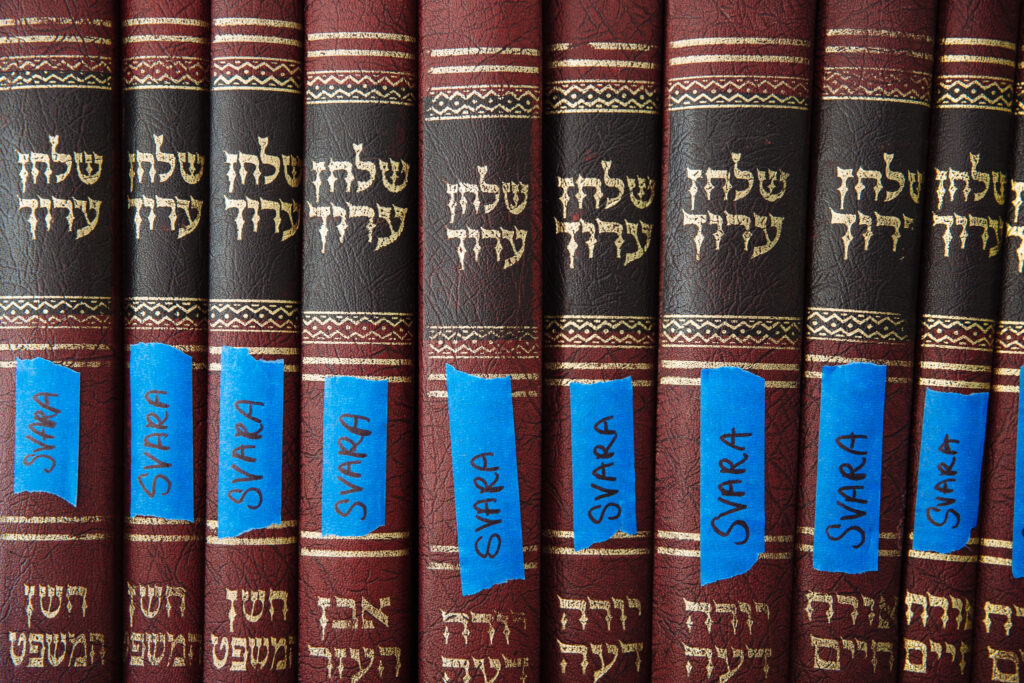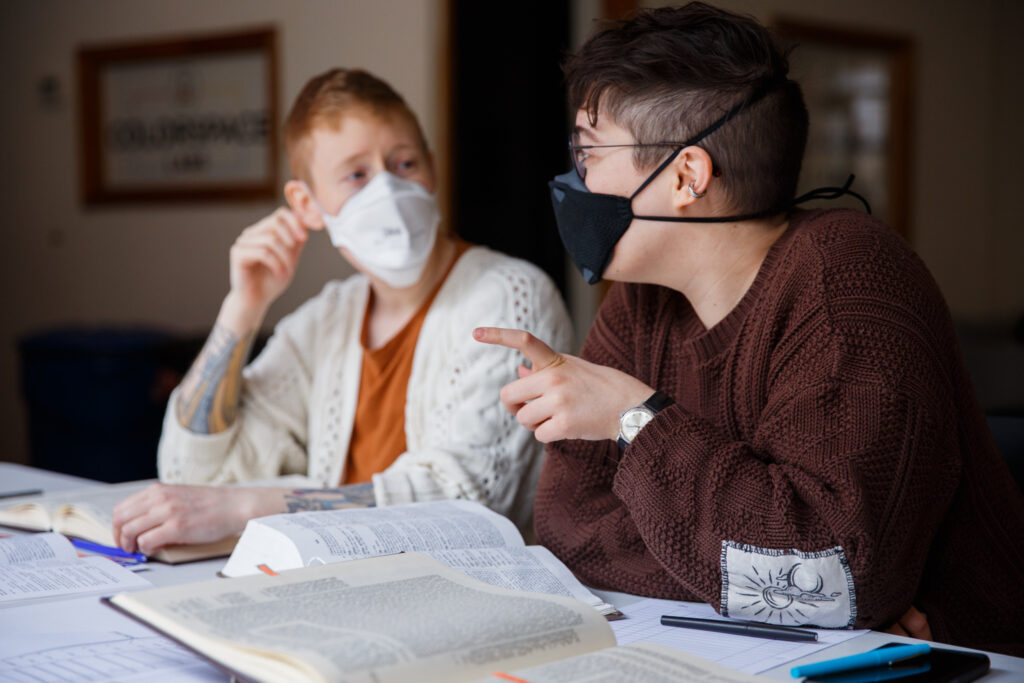In preparation for the start of this zman (semester) of learning at SVARA, which many of us began this week, I genuinely wondered if I would be able to do it. As I move through the grief and challenges of this moment, a part of me felt foolish for going into the beit midrash. Maybe some of you felt the same way.
Even though I knew we had a radically relevant text to learn, I still questioned the very project, wondering, “is now the time to study or is now the time to act?” I tried to conjure Rabbi Akiva, who said “study is greater than action for it leads to action,” but somehow it felt flat. It felt flat because one of the most unique aspects of the SVARA beit midrash is that we’re not trying to indoctrinate our students into certain actions. Although our Rosh Yeshiva is pretty blunt in saying “yes, we are trying to recruit you,” the recruitment is about returning students to their own hearts in response to a world that relies on us outsiders and outliers becoming disassociated from ourselves so we don’t shake things up too much. If there’s one thing SVARA does take as doctrine, it’s that our queer Rabbi ancestors wanted us to inherit their radical legacy of shaking things up and building anew.
Still, with so much ongoing violence it feels like this is a time where certain actions are necessary. But what are they? How do we figure them out? Does the Talmud offer us a blueprint for right action here? Sometimes I think yes and sometimes I think no, because we can all read something very different into this text we’ve inherited. This is why I don’t think the Talmud itself provides us the blueprint for right action; rather, it’s the beit midrash that guides us.
The culture of the beit midrash is centered on interconnection—we are responsible for everyone else’s learning in addition to our own. We recognize that our individual unique wisdom is part of a chain inherited from our queer rabbinic ancestors before us as well as the contemporaries surrounding us and those in the very room of our study. And above all else, we share a commitment to repair of harm because we believe that long-lasting resilience flourishes through interconnection. Interconnection allows us to focus on quality over quantity; interconnection allows us to cultivate patience and appreciation for another’s process and our own; interconnection allows for us to operate from a sense of abundance and shared humanity. Fundamentally the beit midrash, which translates to the “the house of seeking” is about seeking out the different pathways to our shared humanity. If only the world could be like the beit midrash.
And now it’s time for another healthy dose of skepticism. The beit midrash is not an idyllic place, certainly not all the time. Many a beit midrash falls short and folx are driven away. And yet the beit midrash has lasted as a structure in myriads of forms throughout Jewish history, throughout the globe, during many, many, many moments of violence facing Jewish communities. Perhaps it is because of the potential of the beit midrash to be a laboratory for how we want the world to be that Jews have tried again and again to create and recreate it. In our current moment where Jews are not only the targets of extreme violence but also the perpetrators, now more than ever we need a beit midrash that unabashedly strives for its highest ideals, a beit midrash that’s willing to be radically traditional in its ethic and ethos of interconnection. The heart and soul of Judaism may depend on it.
That’s a tall order, a heavy load, to bear. As a teacher the thought has been overwhelming. I’ve laid awake at night wondering, “what happens if folx don’t feel that transformative, interconnected feeling in my beit midrash?” The ego slips in so easily, right? My beit midrash. The fact of the matter is I often worry most about my place in things. Will I be dishonoring the ancestors if I fall short somehow, if I make a wrong move in the sacred space of the beit midrash? Then I feel a shame spiral about my own ego and before I know it my new hevruta is a pint of ice cream and an extra large bag of chips. To my fellow teachers out there, do you feel me?
The amazing thing about our queer rabbinic ancestors is that they were not afraid of exposing their shortcomings, even of the beit midrash itself. (Keep in mind, however, that a lot of their racist, misogynist, ableist and elitist shortcomings would take generations to expose, i.e.- through us. But it is because of the systems they built into the Talmud of debate and change that we get to be a part of the holy endeavor of repairing the harm done under the veil of those shortcomings.) In two different sugyot (sections) of the Talmud we find that Rav Yehuda, a 2nd generation Babylonian Amora, has come to have a significant, if not deeply harmful, disagreement with a student. Rav Yehuda is a prominent teacher of his generation: he is the head of the leading yeshiva (house of learning) in Pumbedita in Babylon and has become such an influential powerhouse in Talmudic learning that he draws thousands of students from Eretz Yisrael and all over Babylon to learn from his teachings, both memorized and recounted from his teachers and his new Talmudic dialectics which will become foundational to Talmud as we know it.
Rav Yehuda is about as dynamic as they come and clearly his yeshiva and its beit midrash is compelling the minds of his generation at a time of great dislocation for Jews. While forced exile is threatening any sense of interconnection between the Jewish community, Rav Yehuda is what one might call idiomatically a “diasporist”– he does not believe that exile from Israel is necessarily a bad thing when the Jewish community can thrive in Pumbedita with his center of learning, well, at the center. In fact, Rav Yehuda will come to actively discourage his students from returning to Israel through a striking midrash (play on verses of Torah) in which he claims that even G!D does not want the Jewish people to return to Israel (see Ketubot 110b, it’s intense). But also on that same daf (page), we read the following passage:
רַבִּי זֵירָא הֲוָה קָמִשְׁתְּמִיט מִינֵּיהּ דְּרַב יְהוּדָה דִּבְעָא לְמִיסַּק לְאֶרֶץ יִשְׂרָאֵל דְּאָמַר רַב יְהוּדָה: כּל הָעוֹלֶה מִבָּבֶל לְאֶרֶץ יִשְׂרָאֵל עוֹבֵר בַּעֲשֵׂה
Rabbi Zeira would actively avoid Rav Yehuda because he wanted to go up to the Land of Israel, for Rav Yehuda said: “Anyone who goes up from Babylon to the Land of Israel has violated a positive commandment [from the Torah].”
In Berakhot 24b we read the almost identical passage:
רַבִּי אַבָּא הֲוָה קָא מִשְׁתְּמִיט מִינֵּיהּ דְּרַב יְהוּדָה דַּהֲוָה קָא בָּעֵי לְמִיסַּק לְאַרְעָא דְיִשְׂרָאֵל, דְּאָמַר רַב יְהוּדָה: כּל הָעוֹלֶה מִבָּבֶל לְאֶרֶץ יִשְׂרָאֵל — עוֹבֵר בַּעֲשֵׂה
Rabbi Abba would actively avoid Rav Yehuda because he very much wanted to go up to the land of Israel, for Rav Yehuda said: “Anyone who goes up from Babylon to the Land of Israel has violated a positive commandment [from the Torah].”
While what unfolds from these two sugyot is very fascinating in terms of how the Rabbis, very clearly, had multiple views about where they wanted to locate themselves—in Babylon or in Israel—what strikes me here is that the Talmud thought it important to show that, two times, a revered teacher managed to make two different students feel so isolated from him that they would actively avoid him. The beit midrash of the early generations (and today as well) is dependent on the relationship of trust and exchange between teacher and student, and yet both Rabbi Zeira and Rabbi Abba felt that it was better to avoid their teacher than engage in disagreement with him. The word for “avoid”—מִשְׁתְּמִיט, has the root ש–מ–ט, which means to loosen or detach. The same root is found in the word shmittah שמיטה which refers to the sabbatical year of the land in which every 7 years the land is allowed to recuperate, loosened from the burdens of harvesting and planting, and where debts are remitted and people are allowed to return to their ancestral homelands. The root can also mean to break loose, to slip off, to be dislocated, and eventually in the present conjugation, to escape or to abandon. A more “inside translation” of these two passages might actually translate the phrase מִשְׁתְּמִיט מִינֵּיהּ as “he (Rabbi Zeira or Rabbi Abba) sought to escape from him.” What a horrible dynamic to emerge between a teacher and a student. Twice!
As a teacher the thought of a student actively avoiding me or trying to escape from me (and effectively my beit midrash as well) is not just horrible but heartbreaking. Clearly the issue was a sensitive one such that the situation arises twice (and in Ketubbot becomes a much larger discourse, definitely worth checking out!). There’s something powerful though in the willingness of the Talmud to expose that one of its great champions, Rav Yehuda, had not created the ideal beit midrash where everyone could feel at home. Interestingly, both Rabbi Zeira and Rabba Abba become Talmudic figures who travel back and forth between Israel and Babylon, transmitting teachings back and forth from Rav Yehuda’s beit midrash and the batei midrash (plural of beit midrash) of Eretz Yisrael.
What we learn from these ancestors is that even when there are disagreements on pivotal matters in our lives, and even when one beit midrash or one teacher or hevruta within it falls short on a matter, the project of the beit midrash is so compelling that we still strive to be in relationship to it. The project of the beit midrash, the space of seeking the paths and the depths of those paths to our shared humanity, transforms the mistakes of our ancestors and our contemporaries into further motivation to improve upon the project and locate ourselves within it. If through the study and development of law, the weaving and reweaving of stories ancient and new cultivates an awareness of the truth of our interconnection and strengthens those ties, then the beit midrash does have that potential to guide us to rightful action—actions that cultivate that interconnection, that celebrate that interdependence, that see transformation and reparation of mistakes as not antithetical to recognizing our humanity but essential to it. Maybe the beit midrash is the precise place for many of us to be right now at this very moment in time. I know, for me, it’s been a deeply grounding space to arrive this week. May we continue to lean into our interconnections, in and outside the beit midrash, as our learning leads to action and back to learning time and again.







